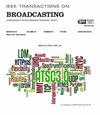TV 3.0: An Overview
IF 4.8
1区 计算机科学
Q2 ENGINEERING, ELECTRICAL & ELECTRONIC
引用次数: 0
Abstract
A new Digital Terrestrial Television Broadcasting (DTTB) system, called Television (TV) 3.0, is being developed in Brazil and is expected to be on air by 2025 under the commercial name DTV+. It started with a Call for Proposals (CfP) for its systems components, for which organizations worldwide have submitted candidate technologies. After two testing and evaluation phases, the technologies for all layers were selected, the TV 3.0 architecture was completely defined, and the standards were written. It consists of modern Modulation and Code (MODCOD) techniques, mandatory transmission and reception in Multiple-Input Multiple-Output (MIMO) with cross-polarized antennas, an app-oriented interface, an Internet-based Transport Layer (TL), and state-of-the-art efficient coding for audio, video, and captions. This set of technologies will allow for several new use cases that change the user experience with TV, such as Geographically Segmented Broadcasting (GSB), targeted advertising, sensory effects, and interactivity. This paper reviews the phases already concluded for the TV 3.0 project and presents its potentialities and the current developments at its final stage.电视3.0:概述
巴西正在开发一种新的数字地面电视广播(DTTB)系统,称为电视(TV) 3.0,预计将于2025年以商业名称DTV+播出。它从系统组件的提案征集(CfP)开始,世界各地的组织已经提交了候选技术。经过两个阶段的测试和评估,选定了各层的技术,完整定义了TV 3.0架构,并编写了标准。它由现代调制和编码(MODCOD)技术、交叉极化天线的多输入多输出(MIMO)强制传输和接收、面向应用程序的接口、基于互联网的传输层(TL)以及最先进的音频、视频和字幕高效编码组成。这组技术将允许一些新的用例,改变用户的电视体验,如地理分段广播(GSB)、目标广告、感官效果和交互性。本文回顾了TV 3.0项目已经结束的阶段,并介绍了它的潜力和目前在最后阶段的发展。
本文章由计算机程序翻译,如有差异,请以英文原文为准。
求助全文
约1分钟内获得全文
求助全文
来源期刊

IEEE Transactions on Broadcasting
工程技术-电信学
CiteScore
9.40
自引率
31.10%
发文量
79
审稿时长
6-12 weeks
期刊介绍:
The Society’s Field of Interest is “Devices, equipment, techniques and systems related to broadcast technology, including the production, distribution, transmission, and propagation aspects.” In addition to this formal FOI statement, which is used to provide guidance to the Publications Committee in the selection of content, the AdCom has further resolved that “broadcast systems includes all aspects of transmission, propagation, and reception.”
 求助内容:
求助内容: 应助结果提醒方式:
应助结果提醒方式:


